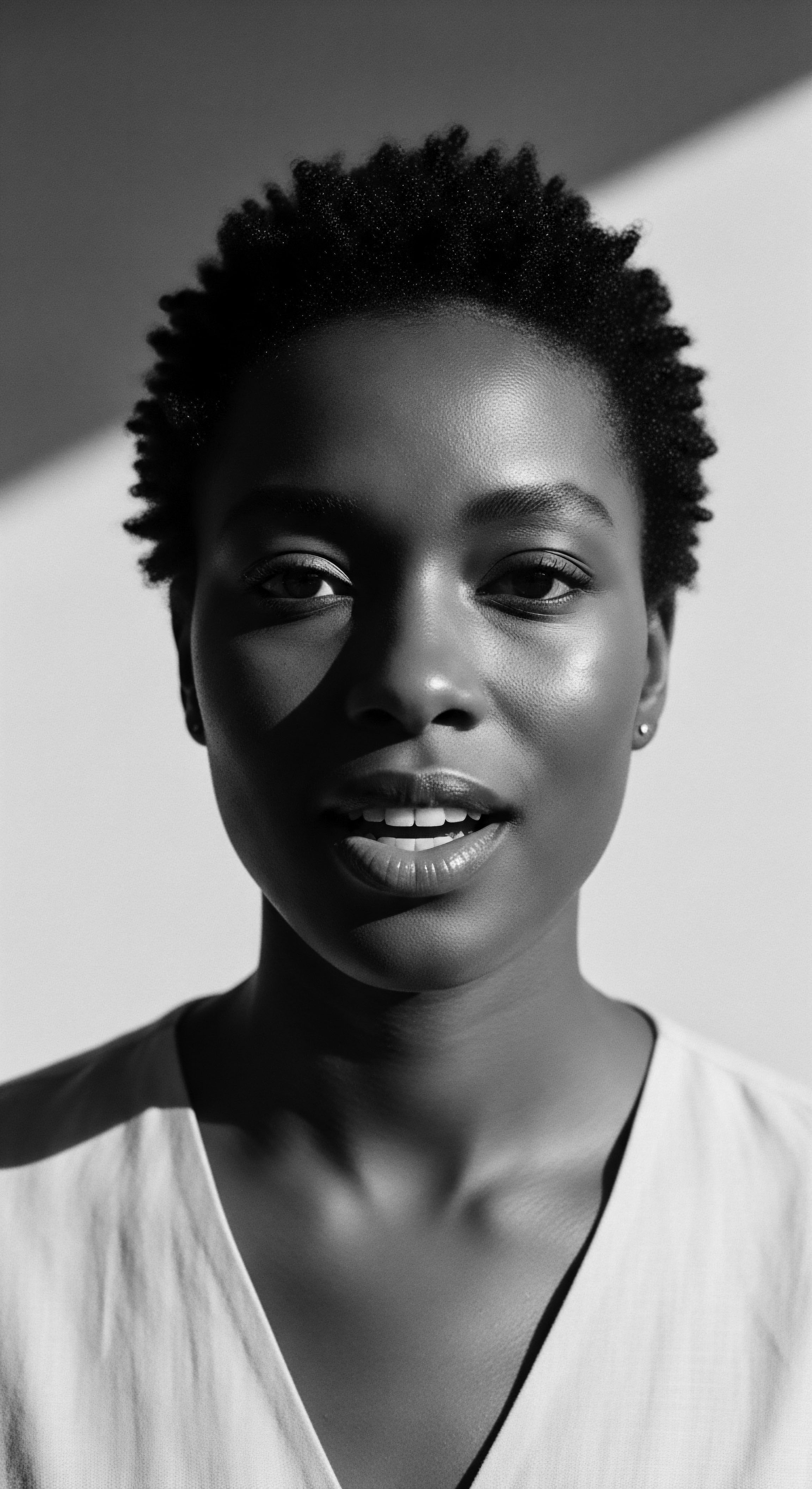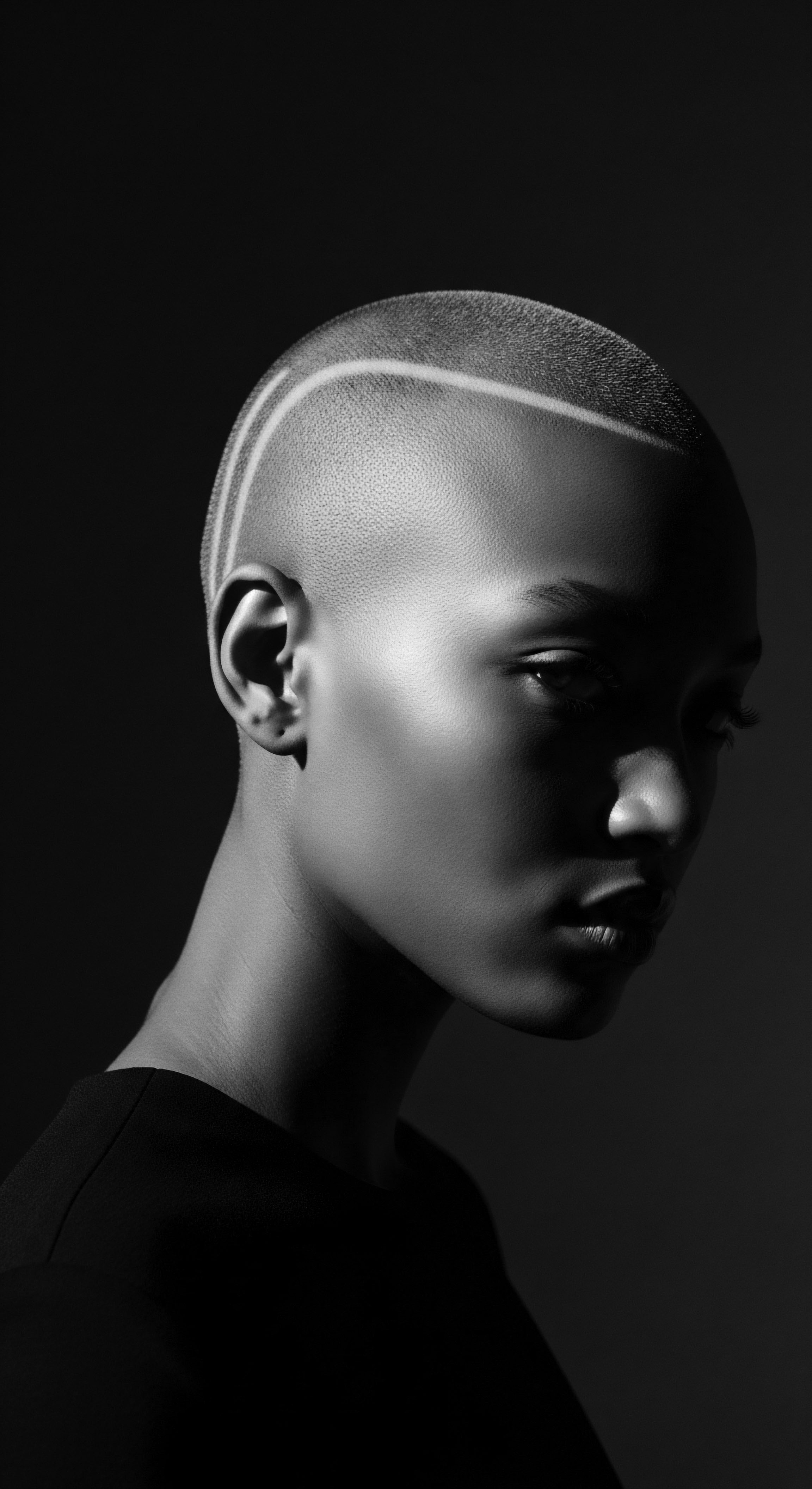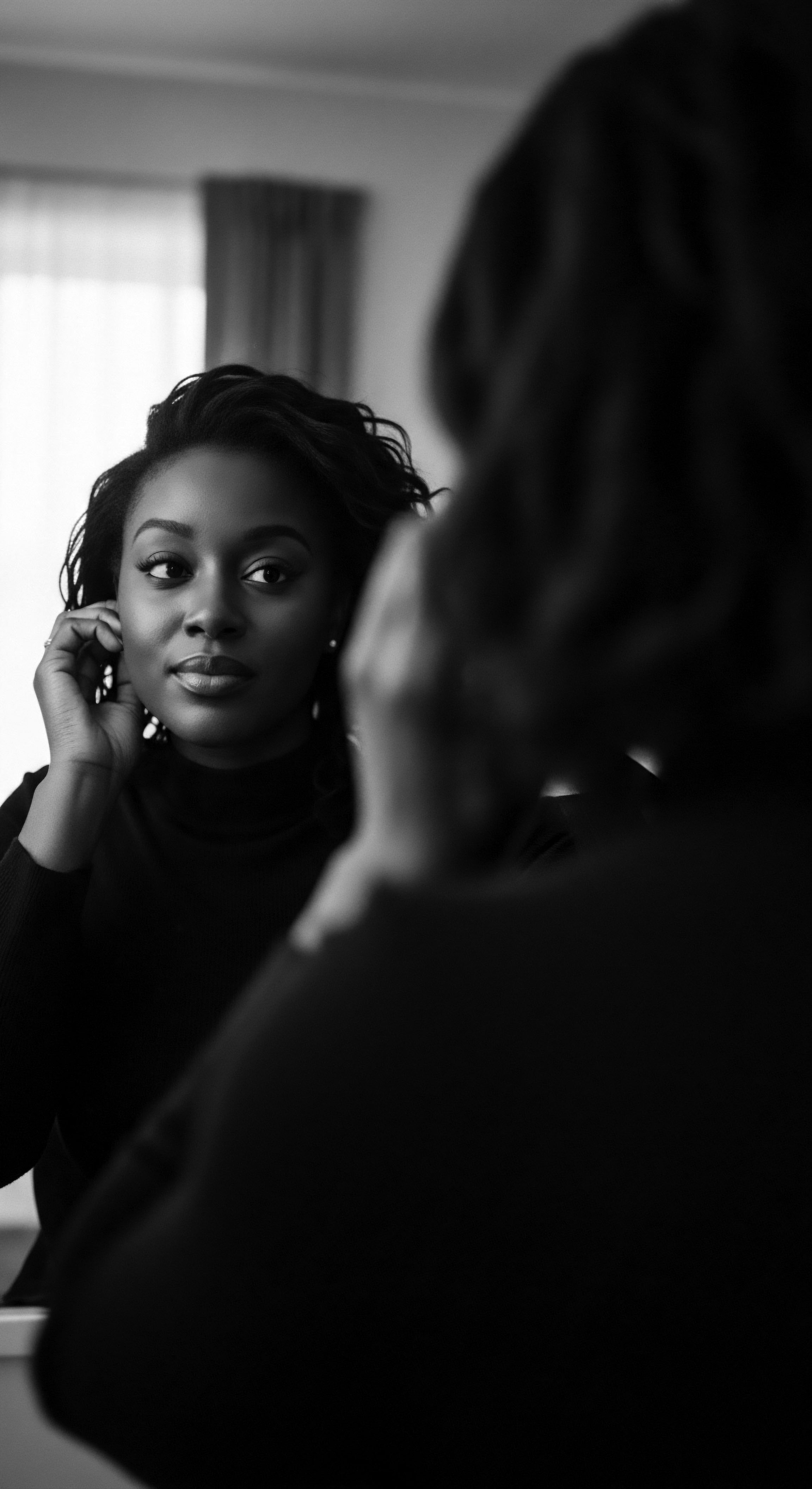
Roots
The very strands that crown us, in their rich coil and varied curl, hold within their structure more than mere biology. They are living filaments, spun from the earth’s ancient wisdom, carrying the whispers of grandmothers and the resilience of generations past. To truly grasp the essence of textured hair, one must journey beyond surface appearance, beyond even modern scientific classification, and listen closely to the echoes from the source, where hair care instruments were never simply utilitarian objects. Their presence, their very fabrication, and their application were often deeply interwoven with spiritual beliefs, acting as conduits between the tangible world and the ancestral realm.
Consider the profound relationship between the human touch, the hair, and the tools that mediate their interaction. These instruments, whether a carefully carved comb, a humble pick, or a smooth stone used for grinding potent herbs, were seldom inert. They were extensions of intention, vessels of meaning, imbued with the spirit of the hands that fashioned them and the spirits invoked during their use.
The practices surrounding textured hair, particularly within Black and mixed-race lineages, speak to a heritage where the head is honored as the seat of the spirit, a sacred space, a direct link to the cosmos. Care for this crown thus became a ritual, and the instruments employed became sacred artifacts in their own right, carrying spiritual significance from their origins to their daily application.

The Head as a Sacred Altar
Across numerous African traditional belief systems, the head, or Ori in Yoruba cosmology, is considered the most sacred part of the body. It is the locus of one’s spiritual destiny, a direct connection to the divine, and the seat of one’s individual spirit. Consequently, anything that adorns, touches, or tends to the hair on the head acquires a heightened spiritual dimension. The choice of instrument, the way it is handled, and the intentions accompanying its use become acts of reverence.
This perspective transforms a simple comb into a tool for aligning oneself with ancestral blessings or for warding off negative energies. The spiritual beliefs connected to these instruments are not abstract; they are deeply practical, woven into the very fabric of daily existence and community life.
Within various West African traditions, for instance, combs fashioned from specific woods, animal bones, or even precious metals often held symbolic meanings tied to protection, fertility, or social status. These were not mass-produced items; each piece was a carefully considered creation, sometimes blessed by spiritual leaders or elder women, carrying the accumulated wisdom and protective energies of the lineage.

Ancestral Wisdom and the Material World
The materials from which ancient hair care instruments were crafted carried inherent spiritual meaning. Wood, particularly from certain trees, might be chosen for its longevity, its connection to specific deities, or its purported healing properties. Bone, often from revered animals, could symbolize strength or connection to the spirit world.
Even the act of gathering these materials, shaping them, and carving intricate designs onto them was often accompanied by prayers or invocations, further sanctifying the tool. This attentiveness to material origin underscores a profound reverence for the natural world and its spiritual energies, a central tenet in many ancestral practices.
Hair care instruments, from antiquity to modernity, frequently served as tangible extensions of spiritual intent and ancestral connection.
In communities where oral traditions dominated, the stories surrounding these instruments became part of their spiritual lore. A comb might be associated with a mythical figure who taught humanity how to braid, or a pick might be a symbol of resilience in the face of adversity, passed down through generations. Such narratives elevated the instruments from mere tools to pedagogical objects, continually reminding their users of their spiritual heritage and communal responsibilities.

Echoes from the Ancient Nile
A powerful historical example of spiritual beliefs linked to textured hair care instruments can be found in ancient Egypt, a civilization where hair played a significant role in social, religious, and spiritual life. Combs, often exquisitely carved from wood, bone, or ivory, have been discovered in tombs dating back thousands of years. These implements were not solely for grooming the elaborate braided and coiled styles prevalent among Egyptians of African descent; they were grave goods, intended to accompany the deceased into the afterlife, signifying the enduring importance of hair and its care in the spiritual journey (Finch, 1990).
The Egyptians believed in a complex afterlife, and preparations for it were meticulously ritualized. Hair, frequently styled with various tools, was seen as a vital component of one’s identity that persisted beyond death. The inclusion of combs and hairpins, sometimes adorned with protective symbols like the Ankh or scarabs, in burial chambers suggests these items were believed to aid in the deceased’s transition and spiritual well-being in the realm of Osiris. This practice speaks to a deep spiritual linkage, where the instruments themselves were seen as essential for maintaining one’s spiritual essence and aesthetic in the eternal journey.

Ritual
The gentle drag of a wide-tooth comb through coily hair, the precise sectioning for intricate braids, the smooth application of balm with skilled fingers – these are not merely styling steps. For generations, these actions have formed a sacred ritual, a tender thread connecting the individual to a vast continuum of ancestral practice. The instruments involved become extensions of this sacred exchange, mediating the transfer of intention, care, and spiritual energy. Understanding this deep-seated aspect of textured hair care demands that we look beyond the functional and perceive the profound spiritual meaning embedded in these daily or weekly acts.
The ritualistic application of hair care instruments often begins with purification. Before touching the hair, hands might be cleansed, and the tools themselves might be blessed or passed through smoke from sacred herbs. This preparatory stage sets an intention, inviting a sacred presence into the act of care. The instruments then become participants in a dialogue between the caregiver and the recipient, between the present moment and the ancestral past.

The Comb as a Spiritual Brush
Consider the comb, perhaps the most ubiquitous of textured hair care instruments. Its teeth, whether few and wide or numerous and fine, perform a systematic motion through the strands. In many African and diasporic traditions, this action transcends detangling; it is a spiritual brush, smoothing not only the physical hair but also the spiritual aura surrounding the head. The act of combing can be a meditative practice, a moment of introspection, or a communal bonding ritual.
- Detangling Energy ❉ The comb can be seen as a tool for releasing stagnant energy or negative vibrations accumulated throughout the day.
- Invoking Ancestors ❉ In some contexts, particularly when used by an elder, the comb might be perceived as a conduit for ancestral wisdom, blessing the hair and the individual.
- Maintaining Order ❉ The very act of bringing order to the hair through combing reflects a desire for order and balance in one’s life, a spiritual discipline.
Among the Himba people of Namibia, for instance, hair care is an elaborate, daily ritual intertwined with spiritual beliefs and social identity. The Otjize paste, a mixture of ochre, butterfat, and aromatic resin, is meticulously applied to their hair and skin using specific tools. While the direct instruments for applying otjize are often specialized sticks or hands, the combs and styling implements used to create and maintain their distinctive dreadlocks are integral to this practice (Cranshaw, 2013).
These tools facilitate the creation of styles that signify age, marital status, and spiritual readiness, acting as essential components of a deeply sacred personal and communal aesthetic. The combs are not just for hair; they are for identity, for connection to the divine, and for signifying one’s place within the spiritual tapestry of the Himba people.

Braiding Tools and Communal Bonds
The process of braiding, particularly complex styles like cornrows or intricate twists, often requires specific instruments for parting, sectioning, and securing the hair. While fingers are often the primary tools, picks, parting combs, and pins are often used to achieve precision and longevity. The communal act of braiding, often done in intimate settings, becomes a powerful ritual of intergenerational knowledge transfer and spiritual connection.
In many communities, braiding sessions are where stories are shared, wisdom is passed down, and spiritual guidance is offered. The tools, touched by multiple hands, become repositories of these shared energies and intentions. They are witness to conversations, laments, laughter, and prayers.
The very act of parting hair with a specific tool might symbolize the discernment of paths in life, and the interweaving of strands might represent the unity of community and the strength found in interconnectedness. This is a subtle yet profound spiritual link, where the instruments aid in a ritual of physical and energetic alignment.

The Significance of the Pick
The pick, especially the Afro pick, holds a potent symbolism rooted in the 20th-century Black liberation movements, but its roots stretch deeper into ancestral practices of volume and shaping. Beyond its utility in lifting and expanding coils, the pick became a statement, a symbol of pride and defiance against oppressive beauty standards. Spiritually, it represents the assertion of one’s natural crown, a rejection of forced conformity.
The act of picking out one’s hair with this instrument can be a spiritual affirmation of self-acceptance and a connection to an ancestral aesthetic that celebrates voluminous, unbound hair. It is a tool for embracing one’s divine, inherent beauty.
The spiritual significance of hair care instruments often lies not just in their physical form, but in the intentions and energies infused into the acts of their use.
These are but glimpses into the expansive realm where practical hair care becomes a ritual, and where instruments transcend their material form to become sacred vessels. The hands that hold them, the beliefs that guide their use, and the heritage that imbues them with meaning all conspire to elevate these objects to a place of spiritual reverence.
| Instrument Type Carved Wooden Combs |
| Traditional Use and Spiritual Connotation Used for detangling and smoothing; often believed to clear negative energy, facilitate ancestral communication, or symbolize status. Materials chosen for spiritual properties. |
| Contemporary Echoes and Heritage Links Still valued for gentle detangling; their natural materials connect users to earth and traditional methods, fostering a sense of grounding. |
| Instrument Type Hair Picks/Afro Picks |
| Traditional Use and Spiritual Connotation Used for shaping and volumizing; represented pride, liberation, and connection to natural hair aesthetic. In some traditions, for lifting spirit. |
| Contemporary Echoes and Heritage Links A symbol of identity and self-acceptance; the act of picking is a conscious affirmation of natural hair and its cultural legacy. |
| Instrument Type Styling Pins/Adornments |
| Traditional Use and Spiritual Connotation Functioned as protective talismans, markers of marital status, spiritual rank, or tribal affiliation. Often imbued with specific blessings. |
| Contemporary Echoes and Heritage Links Modern hairpins and decorative elements often chosen for aesthetic appeal, yet the underlying desire to adorn and protect remains, reflecting historical traditions. |
| Instrument Type These instruments are not mere objects; they are threads in the living tapestry of textured hair heritage, connecting physical care with spiritual lineage. |

Relay
The transmission of textured hair care knowledge, along with its spiritual underpinnings, is not a static archival exercise. It is a vibrant, living relay, passed from elder to youth, from hand to eager hand, across generations. This relay is steeped in an understanding that hair care instruments are more than just tools; they are custodians of ancestral memory, carriers of intention, and physical links in a chain of spiritual continuity. The depth of this transmission lies in its experiential nature, where beliefs are not merely spoken, but lived, demonstrated, and felt through the very act of tending to one’s crown.
The ritual of hair care, guided by these instruments, becomes a form of intergenerational pedagogy. A grandmother teaching a grandchild to comb their hair gently, a mother showing her daughter how to part for braids, these are not just lessons in technique. They are profound spiritual lessons in patience, self-worth, community, and reverence for one’s physical and spiritual heritage. The instrument, a simple pick or a specialized braiding tool, becomes a physical prompt for these deeper teachings.

Are Tools Inherited with Spiritual Meaning?
Indeed, the inheritance of hair care instruments often comes laden with spiritual meaning. A specific comb might be passed down through a family, having touched the heads of multiple generations. In this context, the comb is not merely a piece of wood or bone; it holds the energetic imprint of all those who have used it.
It becomes a familial heirloom, a tangible connection to the ancestors, believed to carry their blessings, protection, or wisdom. The act of receiving such an instrument can be a deeply moving spiritual experience, a formal acceptance of one’s place in the lineage.
In some West African cultures, for instance, a first comb given to a young child might be ritually blessed, signifying a spiritual initiation into the family’s hair care practices and the broader community. This tool then accompanies the individual through different life stages, witnessing rites of passage and embodying a constant spiritual presence. The spiritual relay occurs through the physical object itself, charged with intent and generational energy.

The Communal Consecration of Tools
Beyond individual inheritance, certain hair care instruments might be communally consecrated or used in ceremonies. Consider the elaborate head-dressing rituals in some parts of Africa, where specialized tools are handled by skilled artisans, often spiritual practitioners themselves. These artisans do not merely style hair; they perform a spiritual act, shaping the “ori” and aligning it with divine forces. The instruments they use are thus part of a sacred set, respected for their role in these profound spiritual transformations.
The meticulous care of these tools, their storage, and their presentation are all part of the overarching spiritual practice. They are cleaned not just of physical residue, but also purified of negative energies, perhaps through smudging or specific prayers. This sustained attention reflects a belief in the ongoing spiritual vitality of the instruments. They are active participants in the spiritual life of the community, not passive objects.

Spiritual Protection in Adornment
Many traditional hair care instruments, especially those used for adornment like hairpins, cowrie shells, or beads, carried explicit spiritual protective functions. These weren’t merely aesthetic choices. Cowrie shells, for instance, were often used in hair as symbols of fertility, wealth, and spiritual protection against evil spirits, particularly in West African and Afro-Caribbean contexts.
The act of placing these items in the hair with specialized tools (needles, fine hooks, or even the hands acting as tools) became a deliberate invocation of these protective energies. The tool facilitates the placement of these spiritual safeguards directly onto the “ori.” This practice illustrates how the instruments are integral to the spiritual intent of safeguarding the individual’s spiritual well-being through their hair. A study by Dr.
Henry John Drewal on Yoruba sacred arts and cultural practices frequently documents the intertwining of aesthetic forms, ritual objects, and spiritual beliefs, emphasizing that objects like hair combs and adornments are rarely divorced from their metaphysical roles (Drewal, 1992). This scholarship underscores how deeply embedded spiritual considerations are within the very fabrication and application of textured hair care instruments within certain West African contexts.
The spiritual significance of textured hair instruments is deeply rooted in ancestral practices, reflecting a belief in their power as conduits for protection, wisdom, and connection to the divine.
This complex relay of knowledge, both practical and spiritual, ensures that the understanding of textured hair care instruments as sacred objects continues to flow through the veins of communities, constantly revitalized by each generation that picks up a comb or secures a braid with conscious reverence.

Reflection
The profound connection between textured hair care instruments and spiritual beliefs is a testament to the enduring power of heritage. It is a living archive, not confined to dusty texts or museum exhibits, but breathing within the very act of tending to one’s hair. From the meticulously carved comb of ancient Egypt, designed to shepherd souls into the afterlife, to the everyday pick that asserts identity and pride, these instruments are far more than tools. They are sacred vessels, carrying the spiritual weight of generations, the whispers of ancestors, and the aspirations of those who will follow.
This exploration, deeply infused with Roothea’s ‘Soul of a Strand’ ethos, reveals that textured hair care is not merely about physical maintenance; it is a holistic practice, a communion with one’s deepest self and ancestral lineage. The instruments we use, whether inherited heirlooms or newly acquired pieces, participate in this communion. They hold the potential to be imbued with our intentions, our respect, and our recognition of the hair as a divine crown.
Understanding this connection allows us to approach our hair care with a renewed sense of purpose, seeing each strand as a thread in a grand, spiritual tapestry that stretches across time and continents. It is a call to recognize the sacred in the seemingly mundane, and to honor the enduring wisdom embedded in every single strand.

References
- Drewal, Henry John. 1992. Yoruba ❉ Nine Centuries of African Art and Thought. Center for African Art.
- Finch, Charles S. 1990. The African Background to Medical Science ❉ Essays on African Origins and Paradigms of Health and Healing. Karnak House.
- Cranshaw, Ashley. 2013. The Global Beauty Industry ❉ A Critical Sociocultural Analysis. Palgrave Macmillan.
- Walker, Alice. 2004. The Temple of My Familiar. Harvest Books.
- Hooks, Bell. 1999. Ain’t I a Woman ❉ Black Women and Feminism. South End Press.
- Mazama, Ama. 2003. The Afrocentric Paradigm. Africa World Press.
- Eugenio, Carol. 2011. African Hairstyles ❉ Styles of Yesterday and Today. Book Surge Publishing.
